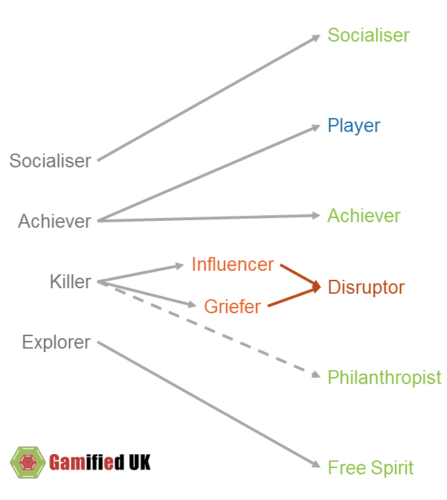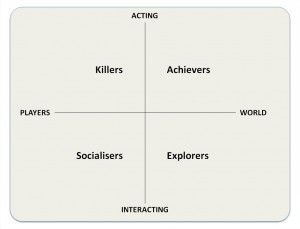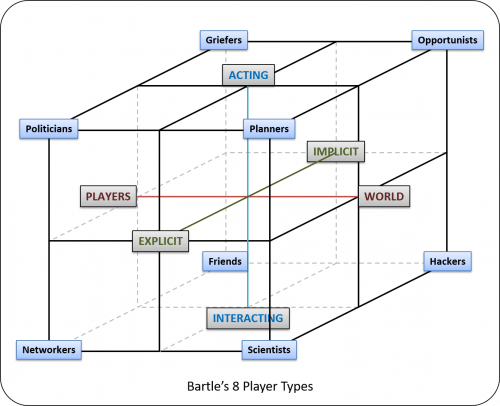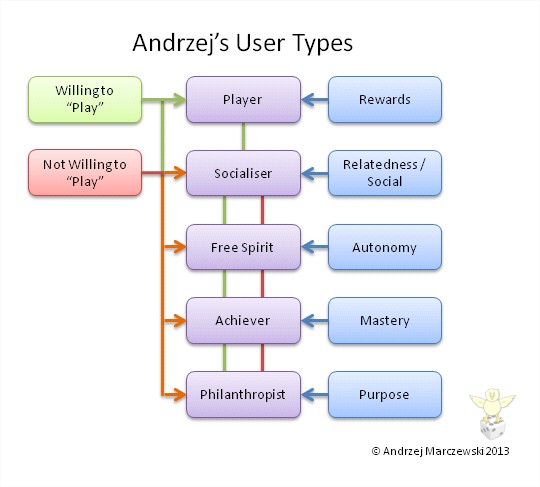There is rather an important update at the end after Richard Bartle offered me some advice!
It had to happen eventually. I had to look at some kind of “player type” theory. Many people have one, Richard Bartle probably having the most famous and most abused of the player type theories out there.
What’s it all about Richard?
For those that don’t know, Richard Bartle labelled players as one of four types to help him understand how they interacted with each other and their environments in MMO games (Massively Multiplayer Online). The labels he used initially were;
- Killer
- Achiever
- Socialiser
- Explorer
Quoting straight from the original text, here is a brief explanation of each of these (very, very brief)
Players use the tools provided by the game to cause distress to (or, in rare circumstances, to help) other players. Where permitted, this usually involves acquiring some weapon and applying it enthusiastically to the persona of another player in the game world.
So, labelling the four player types abstracted, we get: achievers, explorers, socialisers and killers. An easy way to remember these is to consider suits in a conventional pack of cards: achievers are Diamonds (they’re always seeking treasure); explorers are Spades (they dig around for information); socialisers are Hearts (they empathise with other players); killers are Clubs (they hit people with them).
If you want to know more, have a look at his original text http://www.mud.co.uk/richard/hcds.htm.
A Flawed Metaphor for Gamification
After speaking with Richard and exploring others use of his player type theory (Amy Jo Kim’s Social Player Type is a very good reworking), it becomes obvious that as a metaphor for gamification, it is useful but flawed. At the end of the day, gamification is not the same as MMORPG’s – the thing that Bartle’s Player Types is designed for (and of course works well for!). For the most part there is no game play, but it is still a handy way to label people, and we can see similar behaviours. However, there is one massive assumption. Your players WANT to play. In a gamified system, that is not always going to be the case.
As I see it, we need to take a step back and start from just two types of users initially. Those willing to “play” and those not willing to play. Here, when I say play, I mean those who can be engaged with the extrinsic things like badges and trophies. To many, this is of no interest at all. But that does not mean you can not create a system that will engage them as well. You just have to think about it.
Do You Want to Play a Game?
In gamification, I can see five simple user types (there are more, but I want to look at this as simply as Richard did with MMO’s).
- Player
- Socialiser
- Free Spirit
- Achiever
- Philanthropist
Yes, I have indeed stolen two of the original labels – but they fit fine! Each of these five user types can be strongly influenced (though it does not have to be exclusively) by one of the four intrinsic motivators I have previously mentioned, or by extrinsic rewards.
The diagram below shows how this looks.
My User Types (I hesitate to say theory!!)
Players are the ones who like to get the achievements in your system; they like to see their names on the leaderboards. They like the “game” of it all. They are also the most likely to make use of “loop holes” to gain an advantage. They are a group of user types in their own right, Bartle’s Player Types cover them very well though! There to play the game and are happy with the extrinsic rewards.
Socialisers (as in the original Player Type) are the ones who want to interact with others. They like to be connected to others. They are interested in parts of the system that help them do this. These are the ones will evangelise your internal social networks. Most motivated by the social connections aspects of relatedness.
Free Spirits like to have agency. They don’t want to be restricted in how they go through their personal journey. They will be the most creative, have the fanciest avatars, create the most personal content, but also find the most holes in a system. They seek self expression and autonomy.
Achievers are the ones who want to be the best at things, or at least be achieving things within the system. They want to get 100% on the internal learning system. They do this for themselves and are probably not that bothered with then showing off to others about it. (This differs from the original definition, but I could not think of a better word!!). May also be motivated by status as a representation of thier personal achievment They need a system that will enrich them and lead them towards mastery.
Philanthropists want to feel that they are part of something bigger. They want to give back to others. These are the ones who will answer endless questions on forums, just because they like to feel they are helping. They want a system that allows them to enrich others and feel a sense of purpose.
There Can be More than One
As you can see, those willing to “play” can fall into any one of the five categories (or any combination of the five). However (obviously), they are the only ones who will fall into the player type. Those who are not willing to play the game of collect the rewards and climb the leaderboard, can still be motivated and engaged, you just have to try harder and be less obvious. That said, if you look at it – you still have the most powerful intrinsic methods available.
It is easy to see that each type of user will need different types of motivation within your system. It goes again to show that you have to cater for everyone, not just the players with a points and badges system. This is likely to cater only for the smallest number of people.
Depending on how this is received, I may do an additional feature on how the different user types interact with each other (similar to the original Player Types). All I will say is that if you think you may get extreme player type users, make sure your system has as few loop holes as possible!
UPDATE!!! A more Bartle way of looking at User Types
This is pretty exciting (for me at least). I have had an exchange with Richard Bartle after he read this on Google+. He suggested a more structured way of viewing this “theory”. It actually does the one thing I was trying to avoid – makes it fall in line with the way his Player Type Theory is Visualised. However, as he is the one who suggested it, I can’t argue!
For this, we will ignore the player user type. In my model they are the ones who are looking for the extrinsic rewards, and will “play” as long as those are there. They are also a group in their own right that can be broken down and categorised in many ways, including the Bartle Player Type. We are really interested in engaging the other four identifed user types. Richard helped me to see that these types follow a pattern.
- Philanthropists and Free Spirits both prefer to act within a free and unstructured environment.
- Achievers and Socialisers tend to need a structure around them.
- Socialisers and Philanthropists are not looking to gain anything material from the system. They are there (as Richard describes it) for the warm fuzzy feelings they get from engaging with or giving to others.
- Achievers and Free Spirits are there for varying degrees of personal gain. Not in bad way though. Achievers are interested in improving and gaining understanding. Free Spirits want to be able to create and use the system to best suit them.
Material may not be the best word for this type of personal non extrinsic reward – but I can’t think of better at the moment!
My User Types, with a dash of Richard Bartles advice and experience.
Massive thanks to Richard!
This is all very academic, my hope is that it will give people another way to visualise gamification and how to motivate different types of people. It may turn out that this is not the best way of doing it – but that is the joy of our new world. It keeps getting more defined and better understood.
Check out Part 2 of this at User Types in Gamification – Part 2: Players and Balance
Why not take the User Type Test and see which of the 4 basic types you may be?
Similar Posts:
- Where is the Killer / Winner Type in your HEXAD?
- Bartle’s Killers . A misunderstood group of people.
- The Trouble With Types







Andrzej, this is an excellent start, and I give you kudos for taking a lead on adapting this model for the gamification space. I think you’ve nailed two really important points: 1) that of the four new “user” types you’ve identified, two likely prefer a more structured and enabling experience, while the other two will prefer something less-structured and allowing for more autonomy and choice. This could be a very helpful construct in designing the constraints (or lack thereof) of the gamified experience. 2) I actually think the more important distinction you make (even though you downplay it in the follow-up at the end of the piece) is the distinction between the “player” and the “non-player.” In the consumer space, gamification has mostly been applied where we are dealing with “players” — users who are already consuming a site’s content, but are now being encouraged to consume more or more frequently or for longer periods of time. But, as gamification increasingly gets applied inside the enterprise or for health care use cases, we’re mostly dealing with “non-players” — participants who are reluctant to use their company’s HR system, or track data properly in SFDC, or stay on target with their prescription drug or weight loss regimen. In these cases, it is critical to acknowledge up front that the user is not invested in “playing” the experience offered, requiring the gamification designer to be very thoughtful about what rewards (often not extrinsic) which will most likely make participation more worthwhile.
Thanks! I do start with the distinction of player and non player. I think by the end I have got to a stage where the player type user is actually the least important part of the system – they are relatively easy to cater for 🙂
I am sure there is a lot more, but I have a lovely foundation now. Just need to start applying some of this stuff and getting stories of others applying it!